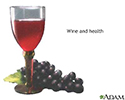Wine and heart health
Health and wine; Wine and heart disease; Preventing heart disease - wine; Preventing heart disease - alcohol
Studies have shown that adults who drink light to moderate amounts of alcohol may be less likely to develop heart disease than those who do not drink at all or are heavy drinkers. However, people who do not drink alcohol should not start just because they want to avoid developing heart disease.
Information
There is a fine line between healthy drinking and risky drinking. DO NOT begin drinking or drink more often just to lower your risk of heart disease. Heavier drinking can harm the heart and liver. Heart disease is the leading cause of death in people who abuse alcohol.
Health care providers recommend that if you drink alcohol, drink only light to moderate amounts:
- For men, limit alcohol to 1 to 2 drinks a day.
- For women, limit alcohol to 1 drink a day.
One drink is defined as:
- 4 ounces (118 milliliters, mL) of wine
- 12 ounces (355 mL) of beer
- 1 1/2 ounces (44 mL) of 80-proof spirits
- 1 ounce (30 mL) of 100-proof spirits
Though research has found that alcohol may help prevent heart disease, much more effective ways to prevent heart disease include:
-
Controlling blood pressure
and
cholesterol
Cholesterol
Hyperlipidemia - cholesterol and lifestyle; CAD - cholesterol and lifestyle; Coronary artery disease - cholesterol and lifestyle; Heart disease - cho...
 ImageRead Article Now Book Mark Article
ImageRead Article Now Book Mark Article -
Exercising
and
following a low-fat, healthy diet
Exercising
Heart disease - activity; CAD - activity; Coronary artery disease - activity; Angina - activity
 ImageRead Article Now Book Mark Article
ImageRead Article Now Book Mark ArticleFollowing a low-fat, healthy diet
A healthy diet is a major factor in reducing your risk of heart disease.
 ImageRead Article Now Book Mark Article
ImageRead Article Now Book Mark Article -
Not smoking
Not smoking
There are many ways to quit smoking. There are also resources to help you. Family members, friends, and co-workers may be supportive. But to be su...
 ImageRead Article Now Book Mark Article
ImageRead Article Now Book Mark Article -
Maintaining an ideal weight
Maintaining an ideal weight
Obesity - managing your weight; Overweight - managing your weight; Healthy diet - managing your weight; Weight loss - managing your weight
 ImageRead Article Now Book Mark Article
ImageRead Article Now Book Mark Article
Anyone who has heart disease or heart failure should talk to their provider before drinking alcohol. Alcohol can make heart failure and other heart problems worse.
References
Brien SE, Ronksley PE, Turner BJ, Mukamal KJ, Ghali WA. Effect of alcohol consumption on biological markers associated with risk of coronary heart disease: systematic review and meta-analysis of interventional studies. BMJ . 2011;342:d636. PMID: 21343206 www.ncbi.nlm.nih.gov/pubmed/21343206 .
Mozaffarian D. Nutrition and cardiovascular and metabolic diseases. In: Mann DL, Zipes DP, Libby P, Bonow RO, Braunwald E, eds. Braunwald's Heart Disease: A Textbook of Cardiovascular Medicine . 10th ed. Philadelphia, PA: Elsevier Saunders; 2015:chap 46.
United States Department of Agriculture. Center for Nutrition Policy and Promotion. Dietary Guidelines for Americans. 2010. National Academy Press. Washington, DC, 2010.
-
Wine and health - illustration
The U.S. Dietary Guidelines recommend that if you drink, do so in moderation and when consumption does not put you or others at risk.
Wine and health
illustration
-
Myocardial infarction
(Alt. Medicine)
-
Coronary artery disease
(In-Depth)
-
Heart-healthy diet
(In-Depth)
-
Atherosclerosis
(Alt. Medicine)
-
Cholesterol
(In-Depth)
-
Omega-3 fatty acids
(Alt. Medicine)
-
Endocarditis
(Alt. Medicine)
-
Hypercholesterolemia
(Alt. Medicine)
-
Vitamins
(In-Depth)
-
Eicosapentaenoic acid (EPA)
(Alt. Medicine)
Review Date: 4/11/2015
Reviewed By: Linda J. Vorvick, MD, Medical Director and Director of Didactic Curriculum, MEDEX Northwest Division of Physician Assistant Studies, Department of Family Medicine, UW Medicine, School of Medicine, University of Washington, Seattle, WA. Internal review and update on 07/24/2016 by David Zieve, MD, MHA, Isla Ogilvie, PhD, and the A.D.A.M. Editorial team.


